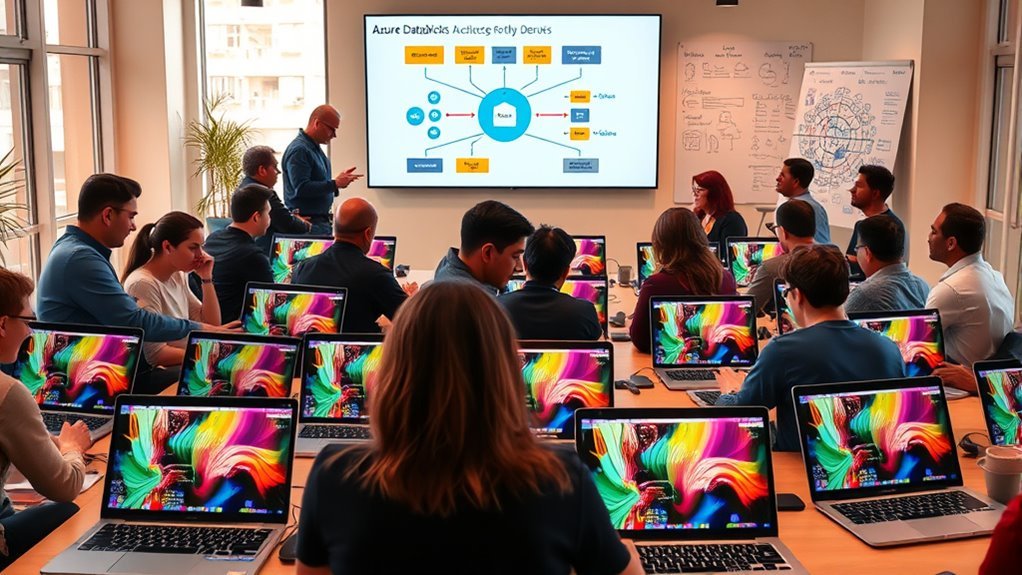You can harness Azure Databricks to streamline collaborative AI development through its scalable, Spark-optimized engine and flexible, role-based workspaces. It supports dynamic resource allocation for large-scale model training and integrates version control to maintain experiment traceability. Its unified environment accelerates data prep, automated tuning, and real-time notebook collaboration, boosting team productivity. Robust monitoring tools guarantee continuous performance optimization and cost efficiency. Discover how to maximize these features for efficient, scalable AI project delivery.
Overview of Azure Databricks Architecture

Although Azure Databricks integrates multiple components, its core architecture centers on a collaborative workspace, an optimized Apache Spark engine, and seamless cloud resource management. You’ll find that Databricks clusters form the backbone, dynamically allocating resources to handle varying workloads efficiently. This flexibility grants you the freedom to scale compute based on demand without manual intervention. Spark integration is deeply embedded, enabling accelerated data processing with built-in optimizations specific to the Azure environment. By abstracting infrastructure complexities, Azure Databricks allows you to focus on AI model development and data engineering. Its architecture guarantees high throughput and low latency, essential for iterative AI experimentation. Ultimately, this design empowers you to harness distributed computing power with minimal overhead, aligning resource management tightly with your project’s evolving needs. This is achieved through the underlying virtualization technology that efficiently manages multiple virtual machines on shared physical servers.
Setting Up Collaborative Workspaces and Permissions

You’ll need to configure your Azure Databricks workspace to balance accessibility with security, ensuring seamless collaboration without exposing sensitive data. Managing user access through role-based permissions helps maintain control over who can view or modify resources, reducing risks. Let’s examine the critical settings and best practices for setting up these collaborative environments effectively. Leveraging advanced data protection features such as encryption and dynamic access permissions further enhances security in collaborative workspaces.
Workspace Configuration Essentials
Before diving into AI model development, it’s vital to configure your Azure Databricks workspace to enable seamless collaboration and secure access. Your workspace setup should leverage configuration options that balance flexibility with control, ensuring your team can innovate without constraints. Key settings include cluster policies, network security groups, and workspace-level libraries, all critical for maintaining a secure yet open environment. Analyzing your project’s scope helps tailor these options—adjusting compute resources and storage access according to data sensitivity and collaboration needs. By precisely configuring these parameters upfront, you not only streamline your team’s workflow but also reduce operational risks. This data-driven approach to workspace configuration empowers you to maintain freedom in experimentation while safeguarding your AI development lifecycle.
Managing User Access
When managing user access in Azure Databricks, it’s crucial to establish clear permission structures that align with your team’s roles and project requirements. You’ll want to implement robust user authentication methods—like Azure Active Directory integration—to guarantee secure, streamlined login processes. Assigning granular permission levels lets you control who can create, edit, or run notebooks and clusters, minimizing risks while maximizing collaborative freedom. Use workspace-level and object-level access controls to tailor permissions precisely, enabling data scientists, engineers, and analysts to work concurrently without stepping on each other’s toes. Regularly auditing permissions based on project phases and team changes keeps your environment both secure and flexible. By balancing stringent authentication and adaptive permission levels, you empower your team with freedom while safeguarding your AI development workflows.
Integrating Machine Learning Workflows With Databricks

Although integrating machine learning workflows with Databricks may seem complex, the platform’s unified environment streamlines data preparation, model training, and deployment. You can efficiently conduct model evaluation using built-in tools that provide detailed metrics, enabling data-driven decisions. Hyperparameter tuning is simplified through automated processes, allowing you to optimize model performance without manual trial and error. Databricks’ seamless integration with MLflow supports tracking experiments and versioning models, granting you freedom to iterate rapidly while maintaining reproducibility. By centralizing these workflow components, you reduce friction between data engineering and data science tasks, accelerating time-to-insight. This approach empowers you to maintain full control over your machine learning pipeline, balancing flexibility with rigorous evaluation standards, ultimately fostering more robust, scalable AI solutions within your organization. Moreover, leveraging automated workflows enhances team productivity and collaboration throughout the ML lifecycle.
Leveraging Notebooks for Real-Time Team Collaboration
Maximizing the impact of machine learning workflows depends heavily on effective collaboration, and Databricks notebooks serve as a powerful tool to facilitate this in real time. With notebook sharing, you can instantly grant your team access to code, visualizations, and results, eliminating delays caused by asynchronous communication. Real time editing enables multiple contributors to simultaneously refine models, debug code, and annotate findings, fostering transparency and accelerating iteration cycles. This immediate feedback loop not only reduces errors but also enhances collective understanding of complex datasets and algorithms. By leveraging these collaborative features, you maintain freedom to innovate while ensuring all stakeholders stay aligned. The seamless integration of notebook sharing and real time editing in Azure Databricks empowers your team to deliver data-driven solutions swiftly and cohesively. Understanding and applying prompt engineering principles further enhances the quality and relevance of AI model outputs during collaborative development.
Managing Data Pipelines and Version Control
You need to automate data pipelines to guarantee consistent, timely processing and reduce manual errors. Implementing version control best practices allows you to track changes, collaborate efficiently, and maintain reproducibility. Together, these strategies enhance the reliability and scalability of your AI workflows in Azure Databricks. Leveraging automated workflows further ensures operational consistency and minimizes manual intervention.
Data Pipeline Automation
Since managing complex data workflows is critical to AI development, automating data pipelines in Azure Databricks guarantees consistent, repeatable processes while minimizing manual errors. You’ll leverage robust pipeline orchestration tools to efficiently schedule and monitor data ingestion, ensuring timely, accurate data flow into your AI models. Automation reduces latency and operational overhead, allowing you to focus on refining algorithms rather than troubleshooting pipelines. By integrating event-driven triggers and scalable workflows, you maintain flexibility and control over data preparation stages. This precise orchestration supports reproducibility and accelerates iteration cycles, empowering you with the freedom to innovate without being bogged down by manual data handling. Ultimately, automated pipelines elevate the reliability and scalability of your AI development environment.
Version Control Best Practices
Although automating data pipelines streamlines workflows, implementing rigorous version control is essential to maintain consistency and traceability in AI development. You should adopt clear branching strategies—such as GitFlow or feature branching—to isolate experiments and production code, enabling parallel development without conflicts. Regular code reviews become indispensable, ensuring quality and facilitating knowledge sharing across your team. They help catch errors early and maintain coding standards. Integrate version control with Azure Databricks by tracking notebooks and pipeline configurations, preserving historical changes and enabling rollbacks when necessary. This structured approach grants you freedom to innovate confidently, backed by a reliable audit trail. By combining disciplined branching strategies with systematic code reviews, you’ll deliver reproducible, high-quality AI solutions while maintaining agility throughout the development lifecycle.
Utilizing Azure Databricks for Scalable Model Training
When handling large datasets and complex algorithms, Azure Databricks offers a highly scalable environment that accelerates model training by leveraging distributed computing. You can implement model scalability techniques and distributed training strategies seamlessly to optimize performance and reduce time-to-insight. Key advantages include:
- Parallel processing across clusters to manage extensive data volumes
- Automated resource scaling that matches workload demands
- Integration with popular ML frameworks for efficient distributed training
- Robust support for hyperparameter tuning at scale
Additionally, Azure Databricks provides dynamic resource management capabilities that allow easy scaling to match computational needs, ensuring cost-effective and efficient model training.
Best Practices for Monitoring and Optimizing AI Projects
Effective monitoring and optimization are critical to ensuring your AI models perform reliably and efficiently over time. You need to establish clear AI performance metrics—such as accuracy, precision, recall, and latency—that align with your project goals. Employ rigorous model evaluation strategies, including cross-validation and continuous testing on fresh data, to detect drift or degradation early. Utilize Azure Databricks’ integrated tools to automate these evaluations and generate actionable insights. Monitoring resource utilization and inference speed will help you optimize computational costs without sacrificing performance. By systematically analyzing metrics and refining models iteratively, you maintain flexibility and control over your AI development lifecycle. This data-driven approach empowers you to balance innovation with stability, ensuring your AI solutions remain robust and scalable in dynamic environments. Incorporating real-time notifications for anomalies can further minimize issue escalation and maintain system reliability.



